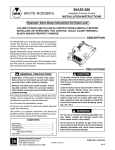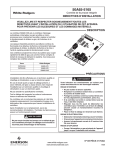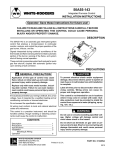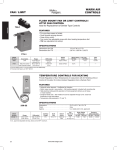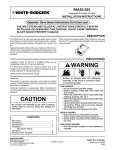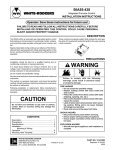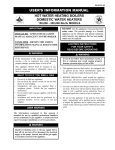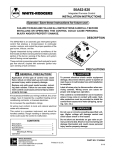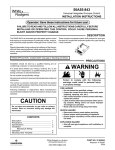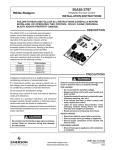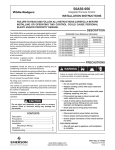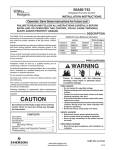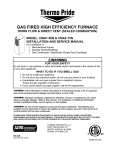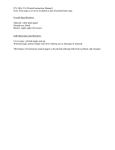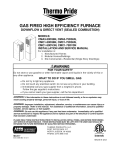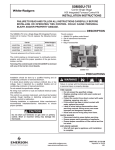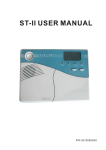Download White Rodgers 50A65-5165 Installation Instructions
Transcript
50A65-5165 Integrated Furnace Control INSTALLATION INSTRUCTIONS FAILURE TO READ AND FOLLOW ALL INSTRUCTIONS CAREFULLY BEFORE INSTALLING OR OPERATING THIS CONTROL COULD CAUSE PERSONAL INJURY AND/OR PROPERTY DAMAGE. DESCRIPTION The 50A65-5165 is an automatic gas interrupted ignition control that employs a microprocessor to continually monitor, analyze, and control the proper operation of the gas burner, inducer, and fan. Signals interpreted during continual surveillance of the thermostat and flame sensing element initiate automatic ignition of the burner, sensing of the flame, and system shut-off during normal operation. These controls incorporates system fault analysis for quick gas flow shut-off, coupled with automatic ignition retry upon sensing a fault correction. It is designed as a replacement for the following controls: Trane White-Rodgers CNT05164 CNT05165 50A65-475 50A65-476 50A65-5165 PRECAUTIONS Installation should be done by a qualified heating and air conditioning contractor or licensed electrician. If in doubt about whether your wiring is millivolt, line, or low voltage, have it inspected by a qualified heating and air conditioning contractor or licensed electrician. Do not exceed the specification ratings. All wiring must conform to local and national electrical codes and ordinances. This control is a precision instrument, and should be handled carefully. Rough handling or distorting components could cause the control to malfunction. Following installation or replacement, follow manufacturer’s recommended installation/service instructions to ensure proper operation. ! CAUTION Do not short out terminals on gas valve or primary control. Short or incorrect wiring may damage the thermostat. ! WARNING Failure to comply with the following warnings could result in personal injury or property damage. FIRE HAZARD • Do not exceed the specified voltage. • Replace existing control with exact model and dash number. • Protect the control from direct contact with water (dripping, spraying, rain, etc.). • If the control has been in direct contact with water, replace the control. • Label all wires before disconnection when servicing controls. Wiring errors can cause improper and dangerous operation. • Route and secure wiring away from flame. SHOCK HAZARD • Disconnect electric power before servicing. • Ensure proper earth grounding of appliance. • Ensure proper connection of line neutral and line hot wires. EXPLOSION HAZARD • Shut off main gas to appliance until installation is complete. www.white-rodgers.com www.emersonclimate.com PART NO. 37-7516A 1409 SPECIFICATIONS ELECTRICAL RATINGS [@ 77°F (25°C)]: Input Voltage: 25 VAC 50/60 Hz Max. Input Current @ 25 VAC: 0.45 amp Relay Load Ratings: Valve Relay: 1.5 amp @ 25 VAC 50/60 Hz 0.6 pf Ignitor Relay: 2.0 amp @ 120 VAC 50/60 Hz (resistive) Flame Current Requirements: Minimum current to insure flame detection: 1 µa DC* Maximum current for non-detection: 0.1 µa DC* Maximum allowable leakage resistance: 100 M ohms *Measured with a DC microammeter in the flame probe lead OPERATING TEMPERATURE RANGE: -40° to 175°F (-40° to 80°C) HUMIDITY RANGE: 5% to 93% relative humidity (non-condensing) MOUNTING: Surface mount multipoise Timing Specs: (@ 60 Hz**) maximum Flame Establishing Time: 0.8 sec Flame Failure Response Time: 2.0 sec **At 50 Hz, all timing specifications should be increased by 20% Gases Approved: Natural, Manufactured, Mixed, Liquified Petroleum, and LP Gas Air Mixtures are all approved for use. TIMING SPECIFICATIONS (All times are in seconds, unless noted otherwise Pre-Purge Ignitor Warm-up Trial for Ignition Period Ignition Activation Period Retries Valve Sequence Period Interpurge Post-Purge Lockout Time Heat Delay-To-Fan-On Heat Delay-To-Fan-Off* Cool Delay-To-Fan-On Cool Delay-To-Fan-Off* Humidifier Electronic Air Cleaner Auto Reset Purge 50A65-5165 0 20 5 2 2 times 15 60 5 300 45 60/100/140/180 2 0/80 Yes Yes 15 *These times will vary depending on option switch position. The control is factory-set at 80 sec. cool delay-to-fan-off and 180 sec. heat delay-to-fan-off. See OPERATION section for further information. INSTALLATION MOUNTING AND WIRING All wiring should be installed according to local and national electrical codes and ordinances. The control must be secured to an area that will experience a minimum of vibration and remain below the maximum ambient temperature rating of 175°F. The control is approved for minimum ambient temperatures of -40°F. Any orientation is acceptable. Refer to the wiring diagram and wiring table when connecting the 50A65 control to other components of the system. UL approved, 105°C rated 18 gauge, stranded, 2/64" thick insulation wire is recommended for all low voltage safety circuit connections. Refer to 50A65 specification sheet for recommended terminals to mate with those on the control. UL approved 105°C rated 16 gauge min., stranded, 4/64" thick insulation wire is recommended for all line voltage connections. Refer to 50A65 specification sheet for recommended terminals to mate with those on the control. The 50A65 has only one serviceable part–an automotive type fuse, which protects the low voltage transformer from damage if its output is short-circuited. If the fuse has opened up, remove whatever caused the short circuit and replace the fuse with only a 5 Amp automotive type fuse. If the fuse is not the cause of the control’s problem, replace the entire 50A65 control. There are no other user serviceable parts. 2 ! CAUTION Do not short out terminals on gas valve or primary control. Short or incorrect wiring may damage the thermostat. ! WARNING FIRE HAZARD • Do not exceed the specified voltage. • Replace existing control with exact model and dash number. • Protect the control from direct contact with water (dripping, spraying, rain, etc.). • If the control has been in direct contact with water, replace the control. • Label all wires before disconnection when servicing controls.Wiring errors can cause improper and dangerous operation. • Route and secure wiring away from flame. SHOCK HAZARD • Disconnect electric power before servicing. • Ensure proper earth grounding of appliance. • Ensure proper connection of line neutral and line hot wires. EXPLOSION HAZARD • Shut off main gas to appliance until installation is complete. WIRING TYPICAL SYSTEM WIRING DIAGRAM HOT (LINE) NEUTRAL (LINE) 120 VAC 24 VAC CLASS II TRANSFORMER TH 24 VAC TR 50A65-5165 COOL HEAT PARK PARK LINE XFMR EAC HUM INDUCER HUMIDIFIER IND IGN IND N IGN N CIRCULATOR BLOWER IGNITOR CIR N LINE N XFMR N HUM N EAC N ELECTRONIC AIR CLEANER 50A65-475 or 50A65-476 in other furnace(s) — TWINNING APPLICATIONS ONLY TWIN* Y Y W W G G R R C COMPRESSOR CONTACTOR THERMOSTAT TWIN* HIGH LIMIT (N. C.) FLAME SENSOR PROBE GAS VALVE HLO FP TH Not Used Not Used TR HLI GND MV COM PS Not Used MV AUX. HIGH LIMIT (N. C.) PRESSURE SWITCH (N. O.) [12-Pin Connector] LEGEND Low Voltage (24 VAC) Line Voltage (120 VAC) N. C. = Normally closed switch N. O. = Normally open switch * The twinning feature is available only onmodelswithsixscrewterminals; one of these terminals will be designated “TWIN”. All 50A65-475, 50A65-476 and 50A65-5165 controls used in twinning applications must have the “TWIN” terminal. IND IGN IND N IGN N 4-Pin Connector HLO PSO HLI FP RO OUT GND PS RO IN TH TR MV COM MV 12-Pin Connector 3 WIRING TYPICAL SYSTEM WIRING TABLE 50A65-5165 TERMINAL TERMINAL TYPE W G R Y SYSTEM COMPONENT CONNECTION low voltage thermostat W terminal (or equivalent) low voltage thermostat G terminal (or equivalent) Terminal block with low voltage thermostat R terminal (or equivalent) low voltage thermostat Y terminal (or equivalent) (2nd wire from Y terminal goes to 24 VAC HOT side of compressor contactor coil) captive screws C TWIN* HLO (Pin 1) FP (Pin 2) TH (Pin 3) (Pin 4) (Pin 5) TR (Pin 6) HLI (Pin 7) GND (Pin 8) MV COM (Pin 9) PS (Pin 10) (Pin 11) MV (Pin 12) IND (Pin 1) IGN (Pin 2) IND-N (Pin 3) IGN-N (Pin 4) COOL HEAT PARK (2 terminals) 24 VAC COMMON side of compressor contactor coil one wire twinning terminal high limit OUTPUT flame sensor probe† HLO HLI FP GND TH IND TR MV COM IGN IND N PS MV IGN N 24 VAC transformer (low voltage HIGH side) not used not used 24 VAC transformer (low voltage COMMON side) high limit INPUT MUST BE RELIABLY GROUNDED TO CHASSIS gas valve COMMON pressure switch INPUT not used gas valve inducer HOT side ignitor HOT side inducer NEUTRAL side ignitor NEUTRAL side spade terminal spade terminal circulator blower COOL SPEED terminal circulator blower HEAT SPEED terminal spade terminal spade terminal unused circulator blower terminals input voltage (120 VAC) HOT side spade terminal spade terminal spade terminal 24 VAC transformer line voltage HOT side humidifier HOT side electronic air cleaner HOT side LINE N XFMR N spade terminal spade terminal spade terminal circulator blower NEUTRAL terminal input voltage (120 VAC) NEUTRAL side 24 VAC transformer line voltage NEUTRAL side HUM N (optional) EAC N (optional) spade terminal spade terminal humidifier NEUTRAL side electronic air cleaner NEUTRAL side LINE XFMR HUM (optional) EAC (optional) CIR N * The twinning feature is available only on models with six screw terminals; one of these terminals will be designated “TWIN”. All 50A65-475, 50A65-476 and 50A65-5165 controls used in twinning applications must have the “TWIN” terminal. † Maximum recommended flame probe wire length is 36 inches. 4 OPERATION OPTION SWITCHES The option switches on the 50A65-5165 control are used to determine the length of the heat delay-to-fan-off periods and cool delay-to-fan-off period. The following tables shows the time periods that will result from the various switch positions. OPTION SWITCH POSITIONS COOL delayto-fan-off: Set switch #1 0 sec. 80 sec.* On Off HEAT delayto-fan-off: Set switch #2 #3 60 sec. 100 sec. 140 sec. 180 sec.* On On Off Off Off On On Off *Factory setting HEAT MODE In a typical system, a call for heat is initiated by closing the thermostat contacts.This starts the 50A65 control’s heating sequence. The inducer blower and optional humidifier are energized and the 768A silicon nitride ignitor is powered within one second. This control has an adaptive algorithm that reduces the ignitor temperature to slightly greater than the minimum temperature required to ignite gas in each particular application. The control measures the line voltage and determines an initial ignitor temperature setting based on the measurement. After each successful ignition, the control lowers the ignitor temperature slightly for the next ignition attempt. The control continues to lower the ignitor temperature until ignition does not occur, and the control goes into retry mode. For the second attempt to ignite gas within the same call for heat, the control increases the ignitor temperature to the value it was on the fourth previous successful ignition. After ignition is successful, the control sets the ignition temperature at this value. The 80 VAC Silicon Nitride ignitor manufactured by White-Rodgers must be used. These ignitors are specially designed to operate with the 50A65’s adaptive ignition routine to ensure the most efficient ignitor temperature. At the end of the ignitor warm-up time, both valves in the 36E manifold gas valve are opened. Flame must be detected within 4 seconds. If flame is detected, the delayto-fan-on period begins. After the delay-to-fan-on period ends, the circulator fan is energized at heat speed. If there is an optional electronic air cleaner on the system, the electronic air cleaner is also energized. When the thermostat is satisfied, the gas valve is de-energized. After proof of flame loss, the delay-to-fan-off period begins and the inducer blower remains energized to purge the system for 5 seconds. When the purge is complete, the inducer blower and humidifier are de-energized. After the delayto-fan-off period ends, the circulator fan and electronic air cleaner are de-energized. If flame is not detected, both valves are de-energized, the ignitor is turned off, and the 50A65 control goes into the “retry” sequence. The “retry” sequence provides a 60-second wait following an unsuccessful ignition attempt (flame not detected). After this wait, the ignition sequence is restarted again. If this ignition attempt is unsuccessful, one more retry will be made before the control goes into system lockout. If flame is detected, then lost, the 50A65 control will repeat the initial ignition sequence for a total of ten “recycles”. After ten unsuccessful “recycle” attempts, the control will go into system lockout. If flame is established for more than 10 seconds after ignition, the 50A65 controller will clear the ignition attempt (or retry) counter. If flame is lost after 10 seconds, it will restart the ignition sequence. This can occur a maximum of 11 times before system lockout. A momentary loss of gas supply, flame blowout, or a shorted or open condition in the flame probe circuit will be sensed within 2.0 seconds. The gas valve will de-energize and the control will restart the ignition sequence. A recycle will begin and the burner will operate normally if the gas supply returns, or the fault condition is corrected, before the last ignition attempt. Otherwise, the control will go into system lockout. If the control has gone into system lockout, it may be possible to reset the control by a momentary power interruption of ten seconds or longer. Refer to SYSTEM LOCKOUT FEATURES. 5 OPERATION COOL MODE In a typical system, a call for cool is initiated by closing the thermostat contacts.This energizes the 50A65 control and the compressor. The cool delay-to-fan-on period begins. After the delay period ends, the optional electronic air cleaner is energized, and the circulator fan is energized at cool speed. After the thermostat is satisfied, the compressor is de-energized and the (optional) cool mode delay-to-fan-off period begins. After the optional delay-tofan-off period ends, the circulator fan and electronic air cleaner (optional) are de-energized. MANUAL FAN ON MODE If the thermostat fan switch is moved to the ON position, the circulator fan (heat speed) and optional electronic air cleaner are energized. When the fan switch is returned to the AUTO position, the circulator fan and electronic air cleaner (optional) are de-energized. TWINNING INTERFACE If the control has six screw terminals, one of which is designated TWIN, the control is equipped with a single wire twinning interface. If twinning is used, either control will process a call for heat, cool or fan as described above. However, after the heat-, cool-, or fan-on delay time expires, both units will energize the circulator blowers at the same time. Likewise, after the heat-, cool-, or fan-off delay time expires, both units will de-energize the circulator blowers at the same time. This allows for proper air flow to be obtained. To assure proper control operation, both controls must share a common transformer ground (TR). To enable twinning, do the following: 1. Power supplied to both furnaces must be from the same phase of the incoming 120 VAC power. 2. Connect the TWIN screw terminals on the 50A65475, 50A65-476 or 50A65-5165 of the furnaces to be twinned to each other using a single wire (14-22 AWG). 6 SYSTEM LOCKOUT AND DIAGNOSTIC FEATURES SYSTEM LOCKOUT FEATURES When system lockout occurs, the gas valve is de-energized, the circulator blower is energized at heat speed, and, if flame is sensed, the inducer blower is energized. The diagnostic indicator light will flash or glow continuously to indicate system status. (System lockout will never override any precautionary features.) To reset the control after system lockout, do one of the following: 1. Interrupt the call for heat or cool at the thermostat for at least one second but less than 20 seconds (if flame is sensed with the gas valve de-energized, interrupting the call for heat at the thermostat will not reset the control). 2. Interrupt the 24 VAC power at the control for at least ten seconds. You may also need to reset the flame rollout sensor switch. 3. After one hour in lockout, the control will automatically reset itself. DIAGNOSTIC FEATURES The 50A65-5165 control continuously monitors its own operation and the operation of the system. The LED light on the control will flash slowly (one flash per second) if there are no failures and no call for heat. If there is a call for heat, the LED will flash quickly (one flash per half-second). If a failure occurs, the LED will indicate a failure code as shown in Troubleshooting section. If the failure is internal to the control, the light will stay on continuously. In this case, the entire control should be replaced, as the control is not field-repairable. If the LED is continuously off, there may be no power to the control; the fuse on the control may be open; or there may be a failure in the control. If the sensed failure is in the system (external to the control), the LED will flash in the following flash-pause sequences to indicate failure status (each flash will last approximately 0.25 seconds, and each pause will last approximately 2 seconds). OPERATION DEFINITION OF TERMS Auto Restart – After one (1) hour of internal or external lockout, the control will automatically reset itself and go into an auto restart purge for 60 seconds. Cool Delay-To-Fan-Off – The period of time between the loss of a call for cool and the deactivation of the blower motor at Cool speed. Cool Delay-To-Fan-On – The period of time after a thermostat demand for cool before energizing the circulator blower motor at Cool speed. Flame Failure Response Time (FFRT) – The period of time between loss of the supervised main burner flame and the action to shut off the gas supply. Heat Delay-To-Fan-Off – The period of time between the loss of a call for heat and the deactivation of the blower motor at Heat speed. Heat Delay-To-Fan-On – The period of time between proof of the supervised main burner flame and the activation of the blower motor at Heat speed. Igniter Warm-up Time – The length of time allowed for the igniter to heat up prior to the initiation of gas flow. Ignition Activation Period (IAP) – The period of time between energizing the main gas valve and deactivation of the ignition means prior to the end of TFI. Inter-purge – The period of time intended to allow for the dissipation of any unburned gas or residual products of combustion between the failed trial for ignition and the retry period. Post-purge Time – The period of time intended to allow for the dissipation of any unburned gas or residual products of combustion at the end of a furnace burner operating cycle. Post-purge begins at the loss of flame sense. Pre-purge Time – The period of time intended to allow for the dissipation of any unburned gas or residual products of combustion at the beginning of a furnace operating cycle prior to initiating ignition. Recycles – The additional attempts within the same thermostat cycle for ignition after loss of the supervised ignition source or the supervised main burner flame. Retries – The additional attempts within the same thermostat cycle for ignition when the supervised main burner flame is not proven within the first trial for ignition period. Trial for Ignition Period (TFI) – The period of time between initiation of gas flow and the action to shut off the gas flow in the event of failure to establish proof of the supervised ignition source or the supervised main burner flame. 7 TROUBLESHOOTING Red LED Flash Error/Condition Comments/Troubleshooting Slow Flash Normal operation Normal – no Call for Heat Fast Flash Normal operation Normal – Call for Heat 2 External lockout (exceeded retries) Failure to sense flame is often caused by carbon deposits on the flame sensor, a disconnected or shorted flame sensor lead or a poorly grounded furnace. Carbon deposits can be cleaned with emery cloth. Verify sensor is not contacting the burner and is located in a good position to sense flame. Check sensor lead for shorting and verify furnace is grounded properly. Verify gas supply to valve, gas valve in "On" position and appliance lighting properly. Verify flame reaches flame sensor during ignition attempts and gas pressures are correct. 3 Pressure switch problem, vent on Inducer problem Check switch function, verify inducer is working correctly. Refer to wiring diagram, terminals PS. 4 Open high temperature limit switch Verify continuity through limit switch circuit. Refer to wiring diagram terminals, HLO. 5 Flame sensed with gas valve de-energized Verify the gas valve is operating and shutting down properly. Flame in burner assembly should extinguish promptly at the end of the cycle. Check orifices and gas pressure. 6 Reversed polarity Verify the control and furnace are properly grounded. Check and reverse polarity (primary or secondary) if incorrect. 7 Gas valve circuit error Indicates the gas valve relay contacts on the ignition module is not functioning properly. Replace the ignition module. 8 Low flame sense current Low flame sense current is often caused by carbon deposits on the flame sensor, a poorly grounded furnace or a mis-aligned flame sense probe. Carbon deposits can be cleaned with emery cloth. Check or improve furnace and module ground. Verify sensor is located in or very near flame as specified by the appliance manufacturer. Refer to wiring diagram FS terminal and GND. 9 Ignition fault Check ignitor or improper grounding Continuous On Control failure Replace IFC Off Control failure Verify power to the control TECHNICAL SUPPORT: 1-888-725-9797 White-Rodgers is a business of Emerson Electric Co. The Emerson logo is a trademark and service mark of Emerson Electric Co. www.white-rodgers.com www.emersonclimate.com








